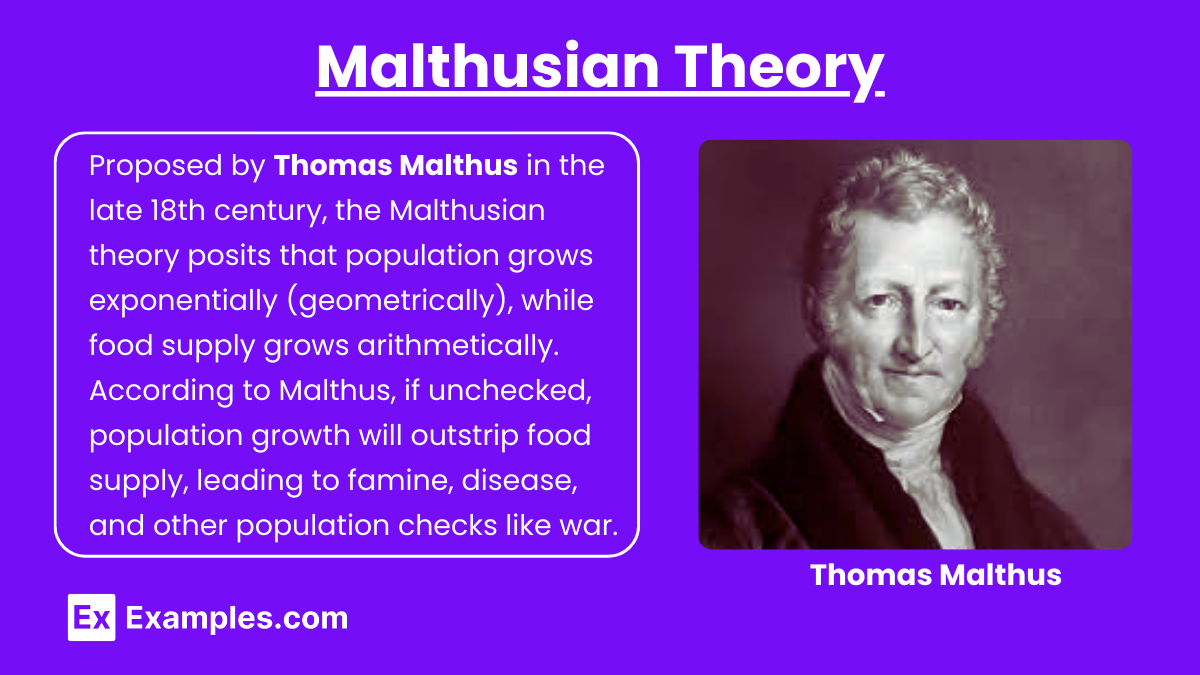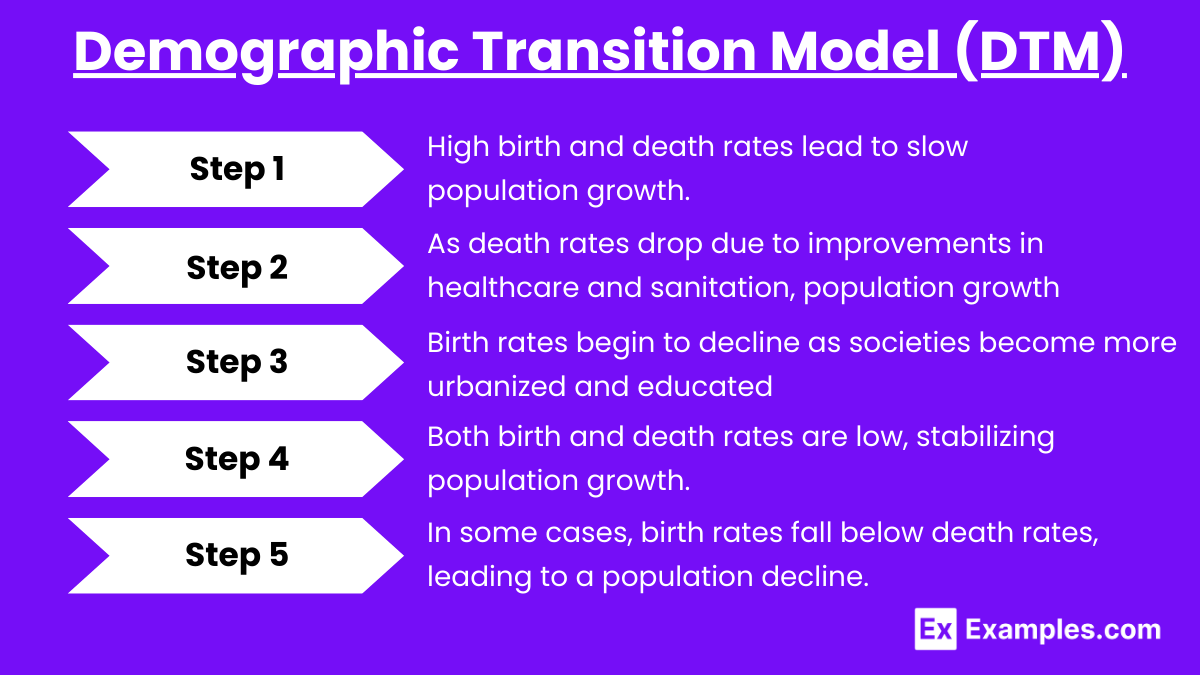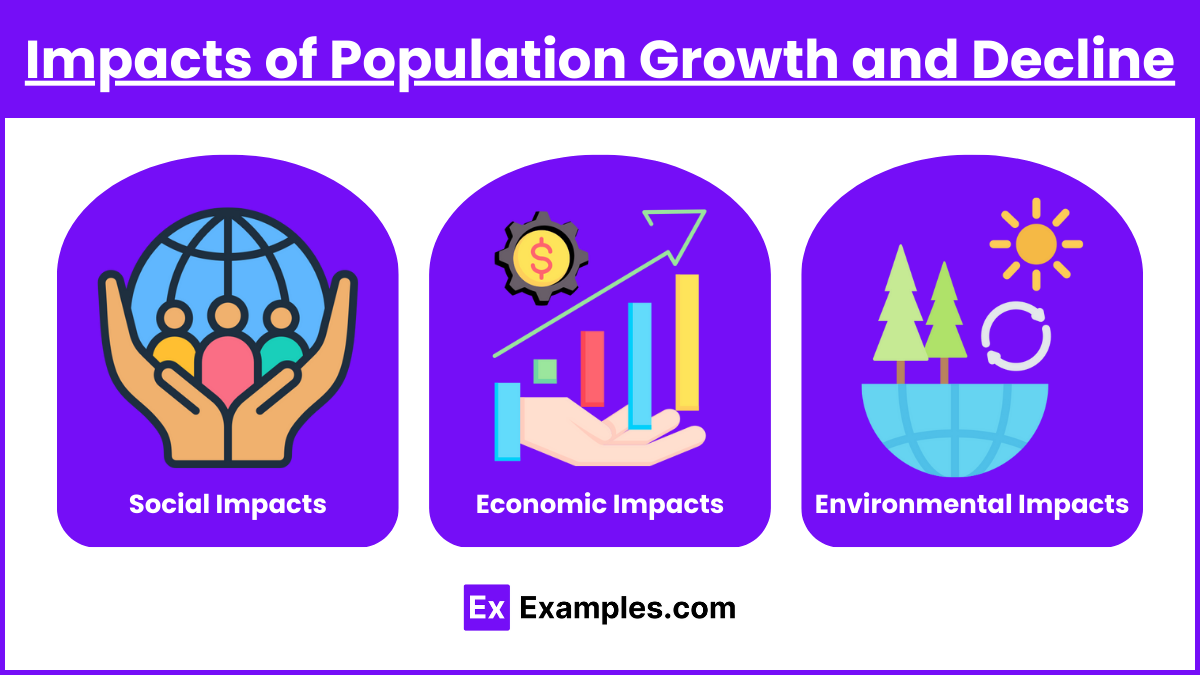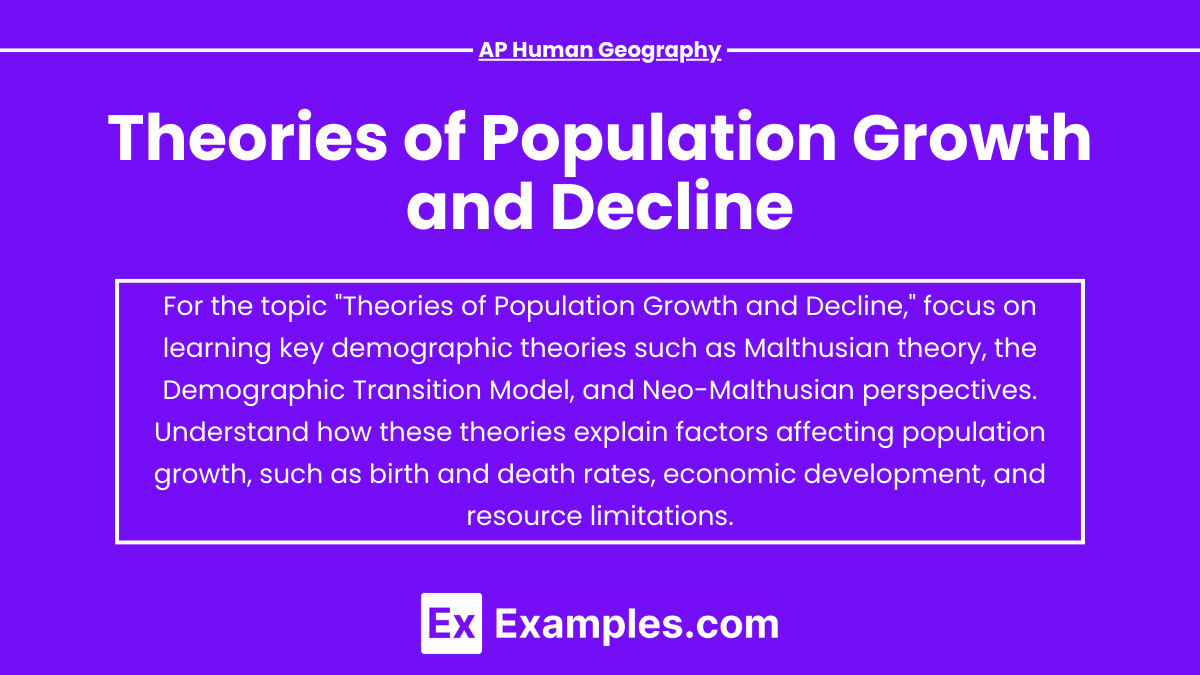In AP Human Geography, the theories of population growth and decline explore the dynamics of how populations expand or shrink over time. Key theories, such as Malthusian, Neo-Malthusian, and the Demographic Transition Model, examine the relationship between population size and resources. Other perspectives, like Ester Boserup’s and Cornucopian theories, focus on human innovation to address resource demands. Understanding these theories is essential for analyzing population trends, their socioeconomic impacts, and how they shape policy responses in different regions of the world.
Free AP Human Geography Practice Test
Learning Objectives
For the topic "Theories of Population Growth and Decline" in AP Human Geography, you should focus on understanding key population theories, including Malthusian, Neo-Malthusian, and Demographic Transition Models, along with contrasting views like Ester Boserup's and the Cornucopian perspective. Learn how these theories explain population dynamics, the factors driving population growth and decline, and the social, economic, and environmental impacts. Also, examine global patterns, replacement-level fertility, aging populations, and policy responses addressing population challenges and sustainable development.
Theories of Population Growth and Decline
Malthusian Theory

Proposed by Thomas Malthus in the late 18th century, the Malthusian theory posits that population grows exponentially (geometrically), while food supply grows arithmetically. According to Malthus, if unchecked, population growth will outstrip food supply, leading to famine, disease, and other population checks like war. This theory highlights the concept of carrying capacity, suggesting that earth has a finite limit on resources that can support a growing population. Malthus advocated for population control methods to prevent these catastrophes.
Neo-Malthusian Theory
Neo-Malthusians are modern proponents of Malthusian ideas. They emphasize that with global population still growing, particularly in developing regions, Malthus’ predictions are still relevant. Neo-Malthusians also stress the importance of family planning, contraception, and education to mitigate overpopulation. They also factor in environmental degradation and sustainability, arguing that population growth exacerbates issues like pollution, deforestation, and climate change.
Demographic Transition Model (DTM)

The Demographic Transition Model explains population growth in relation to economic development, presenting four or five stages through which a society progresses:
Stage 1: High birth and death rates lead to slow population growth.
Stage 2: As death rates drop due to improvements in healthcare and sanitation, population growth accelerates.
Stage 3: Birth rates begin to decline as societies become more urbanized and educated, leading to slower population growth.
Stage 4: Both birth and death rates are low, stabilizing population growth.
Stage 5 (sometimes included): In some cases, birth rates fall below death rates, leading to a population decline.
Ester Boserup's Theory
In contrast to Malthus, Ester Boserup suggested that population growth can stimulate technological innovation and agricultural development, allowing societies to produce more food to meet the needs of the growing population. Boserup’s theory is often referred to as the “cornucopian theory,” and it emphasizes human ingenuity as a solution to resource constraints. This theory suggests that humans will always find ways to expand carrying capacity through technological advancements.
Cornucopian Theory
This theory supports the idea that human innovation, technological advancements, and market forces can overcome resource shortages. Cornucopians argue that population growth leads to innovation that offsets the strain on resources. They reject the notion that overpopulation will lead to catastrophe, believing that human resourcefulness will allow for continued prosperity even with large populations.
Impacts of Population Growth and Decline

Social Impacts: Population growth in developing countries often leads to challenges like overcrowded cities, strain on healthcare and education systems, and increased unemployment. Population decline, on the other hand, can lead to aging populations, reduced labor forces, and the potential collapse of pension systems.
Economic Impacts: Growing populations can fuel economic growth by providing a large labor force and driving demand for goods and services. However, rapid growth can strain infrastructure and resources. Population decline may lead to economic stagnation as fewer people participate in the workforce, leading to lower productivity and innovation.
Environmental Impacts: Both population growth and decline have profound environmental implications. Rapid growth can result in deforestation, loss of biodiversity, and increased carbon emissions, while declining populations can reduce pressure on natural resources.
Examples
Example 1: Malthusian Theory
Proposed by Thomas Malthus, this theory suggests that population grows exponentially while food supply grows arithmetically. Malthus predicted that population growth would eventually outpace food production, leading to widespread famine, disease, and conflict. This theory highlights the potential limits of resources in sustaining human populations, emphasizing the need for population control.
Example 2: Neo-Malthusian Theory
Expanding on Malthus’s ideas, Neo-Malthusians focus on contemporary issues such as overpopulation, environmental degradation, and climate change. They argue that unchecked population growth, especially in developing regions, could lead to severe ecological and resource crises. Neo-Malthusians advocate for family planning, sustainability, and environmental conservation to avoid future catastrophes.
Example 3: Demographic Transition Model (DTM)
The DTM describes the transition of countries through four stages of population growth, from high birth and death rates in pre-industrial societies to low birth and death rates in industrialized nations. This model is used to explain the progression of population growth and decline as countries develop economically, with many developed nations now facing declining birth rates and aging populations.
Example 4: Zero Population Growth (ZPG)
This theory advocates for achieving a balance where the birth rate equals the death rate, resulting in a stable population size with no net increase. The concept of ZPG is important in addressing concerns about overpopulation, as it focuses on maintaining sustainable population levels. Countries experiencing ZPG aim to ensure that their population growth does not exceed their resource capacity, while also preventing population decline.
Example 5: Population Aging and Decline
In many developed countries, low birth rates combined with increased life expectancy lead to aging populations and eventual population decline. This trend poses significant challenges, such as a shrinking workforce and rising healthcare costs to support an aging population. Countries like Japan and Italy are examples where population decline is a growing concern, prompting policies such as immigration incentives and pro-natalist measures to mitigate the impacts of population shrinkage.
Multiple Choice Questions
Question 1
Which of the following best describes the Malthusian theory of population growth?
A) Population growth is linear, while food supply grows exponentially.
B) Population growth will always outpace food supply unless checked by positive or preventive checks.
C) Population growth promotes technological advancements that increase food supply.
D) Governments should promote population growth to stimulate economic development.
Answer: B) Population growth will always outpace food supply unless checked by positive or preventive checks.
Explanation: Thomas Malthus argued that population grows exponentially, while food supply grows arithmetically. According to Malthus, without "positive checks" (like famine, disease, or war) or "preventive checks" (like moral restraint), population growth would outstrip food production, leading to shortages. This theory is pessimistic about the ability of society to keep pace with population growth. Choice B directly aligns with this idea, while the other options either incorrectly describe Malthusian theory or introduce concepts unrelated to Malthus' original ideas.
Question 2
The Demographic Transition Model (DTM) explains population changes over time. Which stage of the DTM is characterized by declining birth rates and low death rates, resulting in slowing population growth?
A) Stage 1: High Stationary
B) Stage 2: Early Expanding
C) Stage 3: Late Expanding
D) Stage 4: Low Stationary
Answer: C) Stage 3: Late Expanding
Explanation: The Demographic Transition Model (DTM) outlines how populations transition from high birth and death rates to low birth and death rates over time. Stage 3, the "Late Expanding" stage, is characterized by a significant decline in birth rates while death rates remain low, leading to slower population growth. This typically occurs as societies become more industrialized, urbanized, and access to contraception increases. Stage 4 represents stabilized low birth and death rates, while Stage 1 is pre-industrial with high birth and death rates, and Stage 2 involves high birth rates with rapidly declining death rates.
Question 3:
Which theory suggests that population growth can lead to technological advancements that increase food production, counteracting the effects of overpopulation?
A) Malthusian Theory
B) Neo-Malthusian Theory
C) Boserup's Theory
D) Demographic Transition Model
Answer: C) Boserup's Theory
Explanation: Ester Boserup's theory challenges Malthusian ideas by suggesting that population pressure encourages technological innovations and improvements in agricultural practices, which can increase food production and support larger populations. Boserup argued that necessity drives invention, meaning that population growth can be a positive force, spurring advancements that prevent the crisis predicted by Malthus. Neo-Malthusian theory supports the original ideas of Malthus, with modern concerns about resource depletion, while the Demographic Transition Model explains population growth in stages without focusing on food supply innovations.


